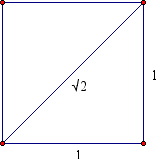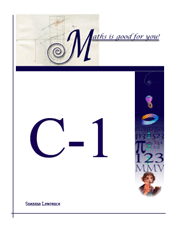
History of Surds
home | courses | topics | theorems | starters | worksheets | timeline | KS3 | KS4 | KS5
The meaning of the word 'surd' is twofold – in mathematics it refers to a number that is partly rational, partly irrational; in phonetics it refers to sounds uttered without vibration of the vocal cords – and so voiceless, 'breathed'. So if you put the two together, you get that surds are 'mute' or 'voiceless' numbers. This is, actually, not a totally loopy statement: as you may know, certain ratios of numbers give pleasing sounds and have been described as far back as the Pythagoras' time. Pythagoreans were credited with the discovery that the sound produced by an instrument is defined by the ratio between the length of a string which produced it and the (in some way, for example by pressing a finger against the string) shortened length of that string. So for example one speaks of a major third (4:5), or a minor third (5:6) in music, and this has a mathematical description – 4:5 or 5:6.
What is important to understand now is the fact that the irrational numbers are also incommensurable with other numbers. Look at the square below:

The side of the square is 1, and its diagonal will be
![]() . As
. As
![]() is an irrational number, its decimal will never end (and it does not have a repeating pattern). This means that you cannot express the ratio between 1 and
is an irrational number, its decimal will never end (and it does not have a repeating pattern). This means that you cannot express the ratio between 1 and
![]() as a rational number and so you will not get a 'clear' ratio – in fact if you attempt to get a sound which is produced from the ratio such as this you will not get a pleasant, clear, sound, merely a shshssssshh of a rather unpleasant quality.
as a rational number and so you will not get a 'clear' ratio – in fact if you attempt to get a sound which is produced from the ratio such as this you will not get a pleasant, clear, sound, merely a shshssssshh of a rather unpleasant quality.
In fact, the
![]() has a rather bloody history to it; it is claimed that the Pythagorean who discovered the property of
has a rather bloody history to it; it is claimed that the Pythagorean who discovered the property of
![]() , namely that it cannot be expressed as ratio of two rational numbers, was drowned at sea. This is because Pythagoreans believed that all of the universe can be described through numbers and their ratios – discovery that some numbers cannot be described as ratios of two other numbers caused them a great deal of confusion.
, namely that it cannot be expressed as ratio of two rational numbers, was drowned at sea. This is because Pythagoreans believed that all of the universe can be described through numbers and their ratios – discovery that some numbers cannot be described as ratios of two other numbers caused them a great deal of confusion.
It is known that Al-Khwarizmi identified surds as something special in mathematics, and this mute quality of theirs. In or around 825AD he referred to the rational numbers as 'audible' and irrational as 'inaudible'. It appears that the first European mathematician to adopt the terminology of surds (surdus means 'deaf' or 'mute' in Latin) was Gherardo of Cremona (c. 1150). It also seems that Fibonacci adopted the same term in 1202 to refer to a number that has no root. In English language the 'surd' appeared in the work of Robert Recorde's The Pathwaie to Knowledge, published in 1551. Robert Recorde was a famous writer of popular mathematics and science books, aimed at those people who wanted to learn more of the subjects and could not attend schools: so workmen, merchants and the like bought Recorde's books to learn practical knowledge related to mathematics or science.
Learn more about the surds here; you can download the revision guide for the whole C1 (Pure Mathematics 1) module here (English syllabus). Click on the picture below.
Or the other famous numbers.
Numbers topics are listed here.
artefacts | numerals | concepts | people | places | pythagoreans | egyptians | babylonians
_____________________________________________________________________________________________________________________
Acknowledgements | Copyright | Contact | Mission Statement | Tell a friend about this site

